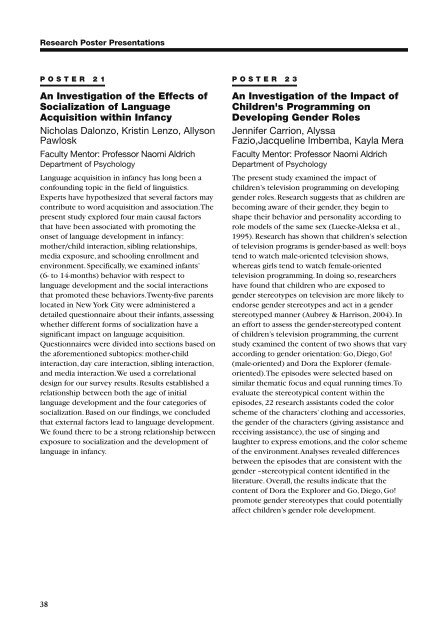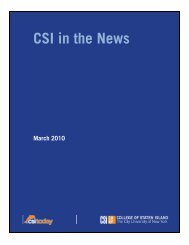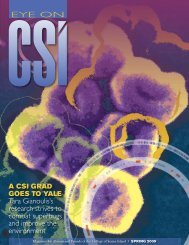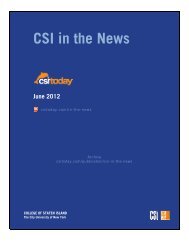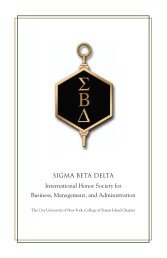csi undergraduate conference on research, scholarship ... - CSI Today
csi undergraduate conference on research, scholarship ... - CSI Today
csi undergraduate conference on research, scholarship ... - CSI Today
Create successful ePaper yourself
Turn your PDF publications into a flip-book with our unique Google optimized e-Paper software.
Research Poster Presentati<strong>on</strong>sP O S T E R 2 1An Investigati<strong>on</strong> of the Effects ofSocializati<strong>on</strong> of LanguageAcquisiti<strong>on</strong> within InfancyNicholas Dal<strong>on</strong>zo, Kristin Lenzo, Allys<strong>on</strong>PawloskFaculty Mentor: Professor Naomi AldrichDepartment of PsychologyLanguage acquisiti<strong>on</strong> in infancy has l<strong>on</strong>g been ac<strong>on</strong>founding topic in the field of linguistics.Experts have hypothesized that several factors mayc<strong>on</strong>tribute to word acquisiti<strong>on</strong> and associati<strong>on</strong>. Thepresent study explored four main causal factorsthat have been associated with promoting the<strong>on</strong>set of language development in infancy:mother/child interacti<strong>on</strong>, sibling relati<strong>on</strong>ships,media exposure, and schooling enrollment andenvir<strong>on</strong>ment. Specifically, we examined infants’(6- to 14-m<strong>on</strong>ths) behavior with respect tolanguage development and the social interacti<strong>on</strong>sthat promoted these behaviors. Twenty-five parentslocated in New York City were administered adetailed questi<strong>on</strong>naire about their infants, assessingwhether different forms of socializati<strong>on</strong> have asignificant impact <strong>on</strong> language acquisiti<strong>on</strong>.Questi<strong>on</strong>naires were divided into secti<strong>on</strong>s based <strong>on</strong>the aforementi<strong>on</strong>ed subtopics: mother-childinteracti<strong>on</strong>, day care interacti<strong>on</strong>, sibling interacti<strong>on</strong>,and media interacti<strong>on</strong>. We used a correlati<strong>on</strong>aldesign for our survey results. Results established arelati<strong>on</strong>ship between both the age of initiallanguage development and the four categories ofsocializati<strong>on</strong>. Based <strong>on</strong> our findings, we c<strong>on</strong>cludedthat external factors lead to language development.We found there to be a str<strong>on</strong>g relati<strong>on</strong>ship betweenexposure to socializati<strong>on</strong> and the development oflanguage in infancy.P O S T E R 2 3An Investigati<strong>on</strong> of the Impact ofChildren's Programming <strong>on</strong>Developing Gender RolesJennifer Carri<strong>on</strong>, AlyssaFazio,Jacqueline Imbemba, Kayla MeraFaculty Mentor: Professor Naomi AldrichDepartment of PsychologyThe present study examined the impact ofchildren’s televisi<strong>on</strong> programming <strong>on</strong> developinggender roles. Research suggests that as children arebecoming aware of their gender, they begin toshape their behavior and pers<strong>on</strong>ality according torole models of the same sex (Luecke-Aleksa et al.,1995). Research has shown that children’s selecti<strong>on</strong>of televisi<strong>on</strong> programs is gender-based as well: boystend to watch male-oriented televisi<strong>on</strong> shows,whereas girls tend to watch female-orientedtelevisi<strong>on</strong> programming. In doing so, <strong>research</strong>ershave found that children who are exposed togender stereotypes <strong>on</strong> televisi<strong>on</strong> are more likely toendorse gender stereotypes and act in a genderstereotyped manner (Aubrey & Harris<strong>on</strong>, 2004). Inan effort to assess the gender-stereotyped c<strong>on</strong>tentof children’s televisi<strong>on</strong> programming, the currentstudy examined the c<strong>on</strong>tent of two shows that varyaccording to gender orientati<strong>on</strong>: Go, Diego, Go!(male-oriented) and Dora the Explorer (femaleoriented).The episodes were selected based <strong>on</strong>similar thematic focus and equal running times. Toevaluate the stereotypical c<strong>on</strong>tent within theepisodes, 22 <strong>research</strong> assistants coded the colorscheme of the characters’ clothing and accessories,the gender of the characters (giving assistance andreceiving assistance), the use of singing andlaughter to express emoti<strong>on</strong>s, and the color schemeof the envir<strong>on</strong>ment. Analyses revealed differencesbetween the episodes that are c<strong>on</strong>sistent with thegender –stereotypical c<strong>on</strong>tent identified in theliterature. Overall, the results indicate that thec<strong>on</strong>tent of Dora the Explorer and Go, Diego, Go!promote gender stereotypes that could potentiallyaffect children’s gender role development.38


